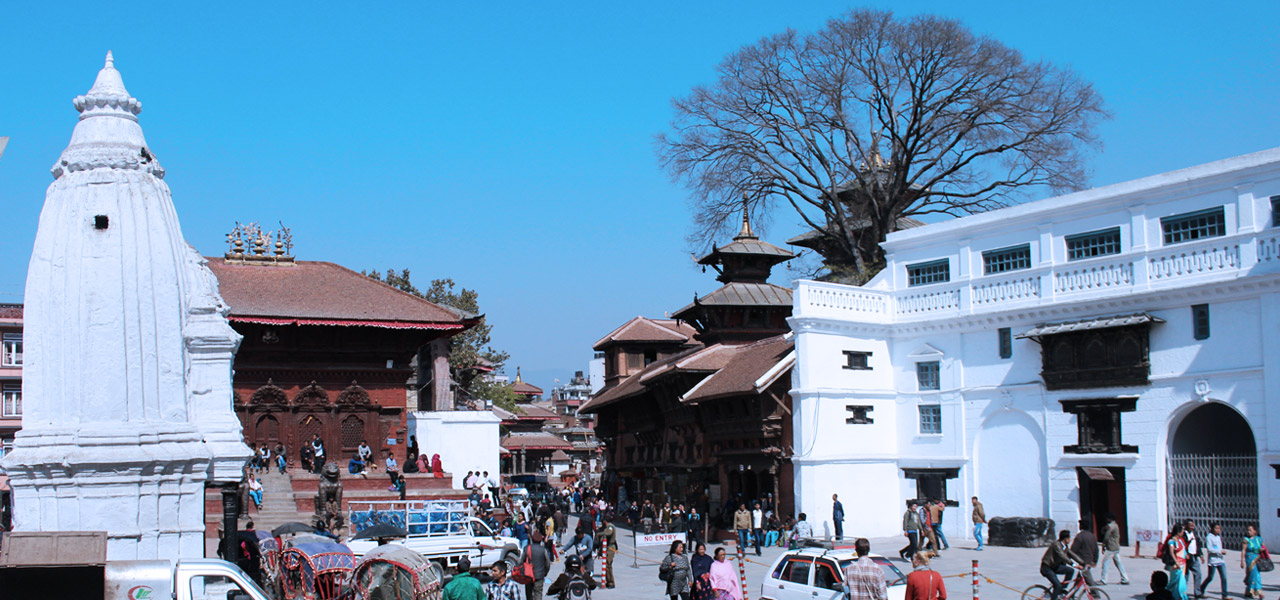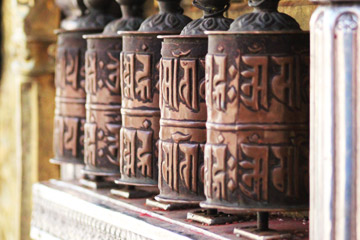The Kathmandu Durbar Square holds the palaces of the Malla and Shah kings who ruled over the city. Along with these palaces, the square surrounds quadrangles revealing courtyards and temples.


The Kathmandu Durbar Square holds the palaces of the Malla and Shah kings who ruled over the city. Along with these palaces, the square surrounds quadrangles revealing courtyards and temples.

Situated western part in the outskirts of the Kathmandu valley, Seto Gumba also known as Druk Amitabh Mountain or White Monastery, is one of the most popular Buddhist monasteries of Nepal.

Nagarkot is renowned for its sunrise view of the Himalaya including Mount Everest as well as other snow-capped peaks of the Himalayan range of eastern Nepal.
It is Simple, Clean and Responsive WordPress Theme which automatically adapts to the screen's size.




When I was reading In Amma’s Healing Room: Gender and Vernacular Islam in South India, I was reminiscing about my first-ever healing experience. I was around 9 or 10 years old when my family and I visited my maternal family in Chennai. Every summer break–we would visit my grandparents in Chennai, and we would not miss going to Marina Beach even in the scorching heat. When my siblings and I were playing in the water I was dragged inside by a strong undercurrent and I almost drowned to death, fortunately, I was pushed to the shore by a bigger wave. After this incident, for the next couple of nights, I was having dreadful nightmares, and I was not able to sleep. My parents didn’t know what to do. From Chennai we went to my paternal grandparents’ house in Vellore, to spend the rest of the summer break. When we reached my grandparents’ house in Vellore, my mother told my grandmother about what had happened to me. My grandmother sensed what it could be, and on the same evening, she took me to a Hindu spiritual healer, which was away from the center of the village. I trusted my grandmother and went through the narrow dark lanes of the village. The spiritual healer was an old frail woman with matted hair living in a straw-thatched hut. The healing hut was wafting with burning incense sticks. My grandmother and I sat in front of the healer on the floor and my grandmother told the healer about what had happened. Immediately, the healer lit a camphor and prayed to the gods displayed next to her and gave me tirunīru (sacred ash), and told me to smear it all over my body. When I went back home, I went to bed directly and slept peacefully. My maternal family believes in Christianity, whereas my paternal family follows Hinduism. My dual religious identity didn’t matter and was never told when I was healed by the spiritual healer. Joyce Flueckiger in her book explores such vernacular healing practice which cuts across religious boundaries.
Joyce’s ‘thick description’ of Amma’s syncretic healing practices gives a new perspective to Islam in South Asia, and how a non-institutional Islamic practice is performed and embodied by Amma in the public sphere through her position and authority. Joyce calls the spiritual healing practice by Amma ‘vernacular Islam’, which is juxtaposed against ‘universal Islam’. Vernacular Islam doesn’t indicate the semantic understanding of Islam, rather it talks about specific relationships and contexts shaped by individuals (2006: 02). The local practices of Islam in Hyderabad through the lens of Amma show fluidity, flexibility, and innovation in a religious tradition.
Amma is as pious as Saba Mahmood’s ‘women of piety’. In her essay “Politics of Piety: The Islamic Revival and the Feminist Subject,” Saba Mahmood argues about the embodied behaviour of her interlocutors. For instance, the virtue of shyness/modesty (al-hāya) is central to a virtuous performer. In contrast to the women of piety, Amma’s embodiment of religious pious is not monolithic. It is fascinating to see how Amma navigates through the gendered space, where Sufi practices are predominately a male space.
As shown in my own experience, a vernacular religious idiom is shared by most religious traditions in India, where spiritual illness is countered by spiritual healing. Amma is a piranima (wife of a pir) who dedicated all her life to learning spiritual healing, however, it is Abba’s presence that validates her authority as a spiritual healer. When Abba dies, her authority is questioned – until her eldest son becomes Abba’s successor. Nevertheless, Joyce argues that they both help each other mutually because most people come to the healing room to seek Amma’s help and guidance. It is her compassionate nature that brings people from all religions and classes to the healing room, and people get to know about Abba only later. One thing that is unique about Amma is her skill and ability to write, which authenticates her vernacular Islamic healing, whereas Abba mostly depends on folktales and oral narratives. Vernacular Islam is more practical than prescribing what is ‘true Islam’.
Amma’s healing room a symbiotic pluralistic crossroads where people across religions experience healing, and healing is received even when someone doesn’t belong to the same faith. However, when it comes to initiation, the individual has to give up her/his former faith practices and rituals completely. In one instance, Amma told Joyce not to eat food offered to Hindu gods or goddesses even though there was no intention of initiation. What are the other limitations of this crossroad? Can habitus be both fixed and flexible?
When Amma talks about two jatis (castes), i.e., male and female which is the only division created by Allah, and the rest of the division is socially constructed. What leaves me thinking is how the term jati is used in this context. Jati is not the only term that is used to signify gender. There is not much clarity on how Joyce distinguishes between jati as gender and jati as caste hierarchy. Furthermore, there is no hint about the hijras (third-gender persons) who are very much part of the Islamic community in Hyderabad (See Gayatri Reddy’s With Respect to Sex: Negotiating Hijra Identity in South India).
In ethnography, does the ethnographer draw a line between being an observer and a participant? Or do they participate always? For instance, during one of the discussions between Amma’s niece and Munappa. They discuss about cremation and burial, towards the end of the discussion, Joyce says that, now she steps down from being an observer and wants to become a participant.
In Amma’s Healing Room is a rich archival source that talks about local Islamic practices. However, Joyce’s well-knit coherent narrative lacks analysis of her interlocutors’ thoughts and perspectives. How important is analysis for ethnographic research?
Looking forward to the discussion!

[Note: This post is written autoethnographically as a stylistic choice.]
I sit down and begin. Gut the book, make something with its contents. Don’t we do this every week?
Natalie Wigg-Stevenson is a theologian, that much is for sure. Besides admitting it in the title (the book is “An Inquiry into the Production of Theological Knowledge), she focuses squarely on a question about theology: “How can ethnographic methods help us foster the already organic relationship between everyday and academic theologies in order to bolster their shared production of theological knowledge?” (10). If anthropologists of Christianity may be aided by knowing something about theology, Wigg-Stevenson wants to use their tools to produce theology. I’ll come back to that last part in a bit.
I say it’s for sure she’s a theologian (as in a systematic one) in part because she uses anthropomorphized theologies. Everyday theologies and academic theologies “relate” to each other in her book—this is fictive relational language. Why not say theologians relate to each other? If a theologian is “made” (47-48), why not focus on the relationship between everyday theologians and academic theologians?
I stand up and grab a book by a theologian. Kosuke Koyama has some of the best book titles; this one is Water Buffalo Theology. He distinguishes between religious traditions (“isms” he calls them) and their practitioners (“ists”) (93-95). Comparison between isms is easy, he says, but talking to other ists is much harder. After all, “Buddhistm does not feel hungry [. . .] Buddhism does not suffer from flood or drought. A Buddhist, on the contrary, [. . .] complains, laughs, grieves, sweats, suffers, thirsts, and hungers” (94). One could just as easily say the same about a Christian, a Jew, a Muslim. This is what makes talking to other ists difficult, even those of the same ism. We have the immediate needs, hopes, hangups, relationships, and emotional reactions that come with having bodies. “Ism and ist are related,” Koyama acknowledges. He makes his point nonetheless: “Don’t let ism walk alone!” (95).
I plop back down with Wigg-Stevenson. To her credit (despite those anthropomorphic theologies), focusing on ethnography means she must focus on people—her study is largely about ists. Two twists distinguish her book from most of what we’ve been reading. First, she implicates herself as one of the study’s ists. She does this in complex ways, drawing first on Bourdieu’s notions of habitus and doxa (and if you can keep these two straight, please help), and then Ortner’s idea of making a field (not just structuring, à la Bourdieu) before connecting directly with Wacquant’s “sociology of the body.” Wigg-Stevenson, though, is not content to “mine knowledge out of the site” of her inquiry like Bourdieu or even Wacquant. She seeks “to produce—or, better, coproduce—knowledge from [her] embodied location within it” (61).
That’s the second twist: Wigg-Stevenson is aware of the ways she influences her fields (both ecclesial and academic), and she’s actively trying to enact (or make, following Ortner) change among her co-participants. She is trying to not only produce knowledge about a particular place and people and their theologies but produce it with and for them (cf. 2). The goal, in other words, is to affect both ists and ism, and to be affected by the process as an ist herself, and it is these attempts and interaction that produce theological knowledge.
I lean back and think for a bit, mirroring (mimicking?) Wiggs-Stevenson’s self-narrated episode on her study floor (66-71). (I do eventually get to the constructive chapters, but in good book-gutting fashion I browse them after having scooped out the theory.) What might all this entail for us in this “field” of Studying Religious Practices? Some of us (like me) want to engage ethnography precisely as part of theological knowledge production; the applications are pretty direct for us. What about those whose projects (seminar-level and larger) are decidedly not theological, at least not in the same way that Wigg-Stevenson’s is? What might they draw from her book? Certainly the role that the researcher has in affecting their field (as seen in Wacquant and the boxing gym). But if there are “moments of slippage and social change” and the researcher, as “objectified participant” has “the power to create them,” then it seems a high degree of reflexivity is absolutely crucial.
I’m tired, and book-gutting is work. I’m left with these questions, which I’d really like my colleagues’ help thinking through. We do this every week, too: We co-produce knowledge.
1. Wigg-Stevenson is focused on the (co-)production of theological knowledge, but in a sense all knowledge produced by ethnography is a co-production. Is the work of other ethnographers to “get the story straight” (Orsi) a different kind of co-production, or is Wigg-Stevenson just being more up front about the ethnographer’s role?
2. What is transferable here? Would someone from a different religious tradition (or none) be able to engage in the same kind of knowledge production that Wigg-Stevenson does, or is it particular only to Christian theology?
3. How is Wigg-Stevenson’s “objectified participation” different (if at all) from being a highly reflexive ethnographer? What distinction is there in the knowledge that it produces?
I once had a professor tell me that every good piece takes into account three things: race, class, and gender. As always, Dr. Frederick weaves these themes into engaging stories and thought-provoking analyses so smoothly it seems effortless. She describes her methods and how she collects said stories. She says that she abides by George Marcus’ proclamation “follow the thing” (p. 8), which she certainly does. Dr. Frederick takes us on a journey around the world, most notably Jamaica, where she helps us to get to know the challenges and needs of communities and how people look toward televangelists to fulfill those needs. Dr. Frederick does not just discuss the actual televangelists, but she also studies and shares knowledge about their congregations and production studios. She truly follows the thing, not just the outward-facing parts but the thing as a whole and multifaceted entity.
Dr. Frederick’s energy about the topic is contagious. I watch a few televangelists, and the book made me excited to watch them some more and helped me to appreciate them, their global impact, and their shared tropes. I am also impressed by how up-to-date the book is. For the time, the pop-culture references are spot on. And to be living in the post-2016 world now and watching the mentees of these personalities follow in their footsteps makes reading the book so engaging and intriguing.
One observation about televangelists that Dr. Frederick makes is that while she studies Black televangelists, those personalities do not necessarily preach Black religion. She describes Black religion as having an element of protestation, but the egregiously famous televangelists that she discusses preach what she calls “American religion.” Which she notes is already global and is not dependent upon Black televangelists to make it so (p.5). This was very interesting to me and prompted me to think about the role of White supremacy in the globalization of American religion and how Black televangelists, their congregations, and their producers participate in this.
By: Mufdil Tuhri
In his 2002 article titled “For Anthropology of Ethics and Freedom,” James Laidlaw introduced the idea of a new subdiscipline within anthropology dedicated to exploring issues related to ethics and freedom. Laidlaw’s proposition marked a departure from his criticism of existing moral frameworks that did not sufficiently emphasize the concept of human freedom. Specifically, he critiqued both the Kantian moral law, which stressed the obligation to adhere to moral principles, and Durkheim’s perspective, which highlighted the role of society in shaping moral norms. Laidlaw proceeded to develop a novel viewpoint that places greater importance on human freedom in ethnographic analyses of ethics. He argued that ethical freedom revolves around the capacity to choose one’s own self-fashioning, setting it apart from agency, which he contended constrains human freedom (315). Drawing from Foucault’s concept of the “technique of self,” Laidlaw further elaborated on the moral significance of ethical freedom in enabling individuals to select and shape their own identities (324). He proposed that achieving this understanding required a thorough ethnographic approach that explores how individuals enact their ethical projects and employ techniques of self-fashioning (327).
While Laidlaw advocated for anthropology to delve deeply into the complexity and diversity of ethical practices across various cultures and historical contexts, Webb Keane’s 2014 article examined two empirical studies on ethics by Joel Robbins (2006) titled “Becoming Sinners” and Charles Hirschkind (2006) titled “Ethical Soundscape,”. He highlighted the complexity of the relationship between deontology and virtue ethics in an ethnographic context. Keane demonstrated that in practice, the separation between moral and ethical concepts is not as simple as in theory (224). Keane also illustrated that ethics becomes separated from everyday habits due to the process of objectivization, as he showed that there is always contestation between religious doctrine and religious practice (230). While distinguishing between ethics within the context of religious beliefs and ethics in everyday routines, Keane underscored that the conflict between religious values and daily practices is key to understanding ethics in religious societies. This persistent tension appears to be a major source of urgency for the piety movement, which equates ethics with piety.
During debates about ethics and morality within the framework of anthropology, there is a tendency for anthropology, which makes it too easy to see the complexity and difference of human lives, and it often ignores the aspect of theology or transcendence in people’s daily experiences. Here, Joel Robbins (2006) seems to want to bridge the anthropological approach, which requires interaction with theology to gain a deep understanding of various aspects of human life. In Robbins’ terms, “we should take on the challenge to find real otherness” (292). Anthropology must ground us in the efforts made by ordinary people in their search for real otherness and describe how they achieve that. Robbins considered that the emphasis on values and ideals encoded and consciously articulated within religious communities is an important part of ethical life, and the rejection of such domains can be inadequate to understanding ethics.
Laidlaw, Keane, and Robbins have collectively offered a theoretical foundation in the field of the anthropology of ethics and morals. It appears that they concur on the necessity for any ethical framework to accommodate conscious reflection regarding social and ethical norms. Their contribution holds significant value in uncovering ethics within human experience, particularly concerning the ongoing debate concerning the role of ordinary or everyday phenomena in shaping ethical life. To me, this will serve as a tool for analyzing various instances of everyday ethics within the broader societal context. Nevertheless, I also acknowledge the anthropological challenges that I may encounter during fieldwork. For instance, for those who argue that ethical life is common and ordinary, how important is it to explain how ethics can be reflective? What if ethics isn’t always fully conscious, for example, in cases where people practice religion as a routine or take it for granted? And what about moral relativism itself?
Since Laidlaw’s complaint in 2002, I believe that there have certainly been significant developments in the study of ethics and morality in anthropology. The various anthropological concepts offered, such as the anthropology of ethics, morality, and freedom, can help enrich our understanding of human complexity in various cultural and religious contexts. Finally, I am also intrigued to think about the various anthropological approaches to religion that have been developed so far. For instance, does the anthropology of morals and ethics aim to broaden the perspective of analyzing the practices of religious communities to a wider extent? So, how do we understand “religion” today if there is already an anthropology of ethics and morality that might be considered more universal?
By: Brittany Fiscus-van Rossum
Mary McClintock Fulkerson’s Places of Redemption utilizes ethnographic research of a church in North Carolina to look closely at how one community lives out its Christian conviction to be inclusive across boundaries of difference (specifically differences in race, ethnicity, and ability). From a theological perspective, McClintock Fulkerson sees this working-out of community convictions through lived practices to be a form of (if still imperfect and incomplete) transformative redemption (21-22). As I was reading Places of Redemption, the question Dr. Seeman posed to those of us in class who are interested in doing theological ethnography came to my mind. How is ethnography useful for doing theological work?
McClintock Fulkerson offers us one example of an ethnographic study with larger theological or ecclesiological implications. McClintock Fulkerson says, “theological reflection is not a linear form of reflection that starts with a correct doctrine (or a ‘wordly’ insight) and then proceeds to analyze a situation; rather it is a situational, ongoing, never-finished dialectical process where past and present ever converge in new ways…the sense that racialized and normate bodily interactions demand attention for faithful life together is not reducible to any classic doctrine of human being” (234). While systematic theology privileges historical church doctrine and “agreed upon” Christian belief, McClintock Fulkerson aims to show in her work that place, embodied practices, relationships, and even contradictions can inform theological reflection. McClintock Fulkerson asserts that there is something to be learned from what living and breathing Christians do and think together in the ongoing process of forming and sustaining a religious community across differences.
I appreciate McClintock Fulkerson’s desire to take seriously how a specific community of Christians work out their theology of living and worshiping together. Just because “what Christians do” cannot always be neatly categorized by traditional doctrinal language, does not make these lived-out practices (and the contradictions within them) any less significant than the solitary pondering of academic theologians or religious figures. I particularly loved her exploration of community practices that were not traditionally associated as strictly Christian in nature (such cleaning and maintaining property, telling stories, and eating together), yet were essential to how this community lives out its Christian vocation (131-143).
While I admire McClintock Fulkerson’s aims to think theologically through the community of Good Samaritan, I am left with some questions after finishing Places of Redemption. I hope we can ponder some of these questions together! At times, I felt as though McClintock Fulkerson makes some sweeping statements about the thoughts and feelings of the different groups at Good Samaritan. For example, she says things like “…the university students’ widely shared preference for Gerald’s ‘more intellectual’ sermons” (90). McClintock Fulkerson’s writing relies heavily on her own analysis of what is happening in a situation. While she does offer dialogue, she seldom includes her own participation in the conversation. Who did she interview to give her the sense that the students’ preferences were widely shared? What were her questions about worship? What assessments does she base on conversations and what is based on observation alone? This may be a mere stylistic preference of my own, but I longed for more direct quotes and longer excerpts from congregant interviews (akin to what we saw in the works of T.M Luhrmann and Robert Orsi) to support her claims about inward feelings, group preferences, and dynamics at Good Samaritan.
Another related topic for discussion has to do with the balance between “thick description” and analysis. Does the “thick description” in Places of Redemption give us an example of theology that is communally created or is the book itself too heavily filtered through McClintock Fulkerson’s own theological and philosophical leanings and perhaps even her own feelings of discomfort?
This brings me to my next question for discussion, which is “what do we think of McClintock Fulkerson’s theological move?” As a practicing Christian myself, I can openly say that I do look for God’s grace among the people of God. I also think that good theology comes out of people in real situations. Yet, it still felt like a big leap to go from description to the claim that “what I trace at Good Samaritan is not simply (incomplete) social transformation; it is divine grace” (246). What a bold claim! Is there a way to make theological observations about lived practices without making totalizing claims like “what I am observing is God’s grace”? What would that look like?
Finally, what do we think about McClintock Fulkerson’s use of ‘habitus?’ Good Samaritan is described as a place that (however imperfectly) tries to habituate people to practices of acceptance, comfort, and belonging that can combat wider social norms of discomfort and prejudice. How does this relate to the idea of religious practices as formational? Do we see these communal practices as forming new ways of being for people? Is this what McClintock Fulkerson would call “redemption”?
I look forward to exploring these and other questions for discussion on Wednesday! Thanks for reading!
-Brittany Fiscus-van Rossum

A lady making duʿā (prayers) after performing ṣalāt at the shrine of Sheikh Hamzah Makhdoom in Srinagar, Jammu and Kashmir (Photo by Yawar Nazir)
This week’s readings extend to an ethnographic exploration to comment on the conventionalities of rituals and the moral order. Borrowing the words of Clifford Geertz, where he defines ‘man’ as an ‘animal suspended in webs of significance he himself has spun’, the readings revolve around finding a greater meaning to the rituals in different religious communities, both in individual and collective dimensions (Geertz, 1977:5; Seeman, 2015:743).
In her thought-provoking essay titled “Rehearsed Spontaneity and the Conventionality of Ritual: Disciplines of ṣalāt”, Saba Mahmood offers a profound engagement with the discourse surrounding the diverse interpretations of the Muslim act of prayer (ṣalāt) within the context of the contemporary Women’s Piety Movement in Cairo, Egypt. Mahmood’s analysis departs from the idea that common gestures and behaviors are necessarily aligned with shared objectives. She investigates the interplay between specific structures of self and authority concerning differential relationships, particularly rituals. Her aim is to demonstrate the intricate and diverse connections between these concepts, contingent upon the discursive and practical circumstances of authority and varying conceptions of personhood.
Within the context of ṣalāt, Mahmood learned women utilize self-expression as a technique to comprehend the body as a developing ‘means for realizing the pious self’ (828). The act of praying five times a day, according to her interlocutors, is an act of ‘pedagogy’. This continuous performance of an ‘act’ to gain closeness makes me think back to our discussion from Tanya Luhrmann’s work on making God real by gaining closeness to Him through practice and performance. The argument that we worship to believe appears analogous to these women’s inclination to view prayer as a method for cultivating closeness to God.
From Mona Hilmi’s interpretation of prayer to create humans capable of “enlightened criticism” to Hajja Samia’s prescription of fear as a necessary condition of piety to reach God, it is evident that ritual behaviours are motivated by the personal desire to find meaning in worship. I agree with Mahmood that the body and its behaviors are the theaters where ideological scripts are enacted, and ‘different’ readings can be assigned (839). What interested me more in the reading was to look at how fear comes to be constituted as a motive or modality for pious conduct. It struck me why invoking fear is essential to acting with virtue. Why do our daily activities of not lying or doing any wrongdoing stem from this ‘fear’ of God’s wrath, and can we think of it positively, as Hajja Samia believes?
Mahmood’s engagement with thinking about induced weeping was interesting. While we mainly resort to crying on our prayer mats to seek forgiveness or ease our sufferings, we see that the women in the mosque were mandated to think of this act as a sense of being overwhelmed with God’s greatness and enacted with the action of pleasing Him. To some theologians, the former act is idolatrous (shirk) (843). With the process of acquiring different resources to cultivate ethical and moral abilities, I invite all of us to think, just as Mahmood prompts us: How can we reimagine freedom when we can no longer assume a clear separation between a person’s genuine desires and societal norms? How do we think, in the cases Mahmood mentions, that freedom is contextual rather than universal to practices?
In a similar vein, Don Seeman’s piece on “Coffee and the Moral Order: Ethiopian Jews and Pentecostals against Culture” explores the manifestation of another form of ritualistic agency. He analyzes the materials as mediums of cultural symbol, which inform the moral experience around which different Ethiopian groups negotiate over the limits of ‘culture’ and the elusive moral freedom. In the examined context, the consumption of buna functions as a sociocultural mechanism to facilitate familial harmony and promote women’s solidarity. However, showing resistance to such a culture acts as freedom of defiance from certain cultural elements that seem intolerant to some.
Seeman asserts that buna avoidance creates a “culture of no culture” to highlight how cultural discourse can be claimed, altered, and disputed in different religious, social, and institutional contexts (743). His advice is that buna practice and avoidance must be understood against an intersubjective horizon of emotionally fraught relationships with kin or neighbors, economic pressures, and the shifting embodied experience of gender and sexuality (743–44). As Mahmood argues for diversity in the language of understanding cultures, Seeman emphasizes accepting differences in the meanings of freedom vis-à-vis rituals. With this, I invite all of us to think about how we determine the extent of freedom within the context of habitus, cultural background, and customary actions, particularly when these are intertwined with rituals.
Robert Orsi’s History and Presence (2016) is an ambitious project to rethink history in relation to the human experience of divine ‘real presence.’ Drawing upon human experiences of God present in the Eucharist, the apparitions of the Virgin, or the worshipping of saints, Orsi claims that human-divine encounters (what he calls ‘abundant events’) are crucial for understanding modern religious history ‘at all levels.’ (73) Orsi’s ‘logic’ of how ritual works is one of Asad’s when he criticizes Geertz’s Protestantism-based view of culture as highly symbolic. For Orsi, the ritual affects and directs human interaction with the world; moreover, the presence of saints makes one “more efficacious in their actions upon the world.” (67) Orsi is not at ease with the modern understanding of religion that treats divine presence as merely symbolic, and his book tries to debunk that image, drawing upon the lived devotional practices of Catholics.
Orsi is audacious in his attempt to theorize the experiences of Catholics in history by drawing upon the data he had gained talking to contemporary Catholics. Listening to the Catholics’ accounts of their encounters with the supernatural, Orsi translates those contemporary experiences into the historical past – going as far as the events of the St. Bartholomew’s Day massacre (17). Orsi is well-versed in Catholic doctrine and his assessments of human experiences are affected by how Catholicism as a system of beliefs interprets those experiences.
Drawing on multiple instances of human experiences of divine ‘real presence’, Orsi makes an important point: history narrates human experiences. The ‘real presence’ that the Catholics encounter in their relationship with the divine is one such experience that must be taken into account when we construct narratives of religious history. However, Orsi writes about Catholics and from a Catholic perspective, which creates a very specific way frame of understanding human experience, human understanding of the divine, and the relationship of the divine with the mundane. It is obvious that Orsi is not trying to make totalizing claims of what constitutes the divine-human relationship; he is aware of his commitment to talk about Catholics, which is evident even in his distinguishing between the terms ‘real,’ ‘present,’ and ‘real presence.’ Orsi intentionally uses the term ‘real presence’ to talk specifically about the experiences of Catholics and within the framework of what Catholicism considers as really present (8). Orsi makes more universal claims about including the accounts of lived devotional experiences in historical writing, especially the ‘modern’ one that denies divine presence. I gained from Orsi’s narrative that he does not account for the dynamism of history and religion. I had an impression that he assumes that the devotional experiences of Catholics are the same or at least similar in all historical epochs (though, he hints at the dynamic nature of religious experience when talking about Vatican II and his mother on pp. 210-11). The book left me wondering whether it is feasible to do an ethnography of the past (Orsi is not the only author who attempted to do that).
Based on this reflection, I invite you to think with me about the following questions:
The first thing that struck me from T.M. Luhrmann’s work in How God Becomes Real was the psychology-anthropology approach. She develops concepts and categories of analysis focused on how our individual decisions determine if Gods and spirits are real so one develops a relationship with the invisible other. While this claim regarding the individual qualities of her work might seem obvious when contrasted with the work of Geertz, Carteaux, and Bourdieu, whose thesis take a broader, almost abstract cultural and collective approach, Luhrmann’s endeavor stands out for its unintended emphasis on the concept of agency: the unpredictability and multiple shifts of individual behavior. Her focus on intentions, predispositions like absorption, desires, choosing what to believe – as a cognitive process – and what experiences one engages, expects, feels, or becomes attentive to -Faith Frames, Paracosms, training in specific skills or practices like praying- prove how individuals establish a relationship with an invisible other and it’s not solely a matter of culture or external influences. Gods and Spirits become not only real but play a significant role in people’s lives due to individual decisions.
Two reflections resulted from my encounter with her emphasis on individual agency: First, Luhrmann’s work led me to reflect on the importance of studying psychological processes in order to shed light on the recent changes in the religious landscape. For instance, it can contribute to conversations about religious markets and economies, where people choose religious goods based on their functionality. How is it related to defining “how” people experience God? Also might be helpful to explore how psychological studies in general and Luhrmann’s categories on how people experience God, help explain the decline of the institutional church in the West and the growing participation in other faith traditions around the globe. What has been the change in “how” people experience God? Finally, it can guide us to understand more in-depth why people nowadays are more likely to explore or combine spiritual experiences that differ from their family’s or communities’ traditions, which introduces us to my second reflection.
While reading Luhrmann’s work I couldn’t help to recall constantly how my culture, family, and several historical developments helped me embrace the faith frame of Pentecostalism, accept its paracosm with great commitment, train in the skills required to make Jesus, Jehová and the Holy Spirit real and therefore engage in a real relationship with them. Prayers, the word of God in scripture, authoritative relationships, congregational supernatural experiences, and my own level of absorption led me to experience God as real. However, for diverse reasons, I stepped out of such a frame of reality. In that sense, despite all the documented good effects of experiencing God as real, I resonate with Luhrmann’s claims on how certain individual commitments to such a real God are not always beneficial at the individual and social levels. I see some harmful effects on myself, as well as in the lives of women around me in the communities I intend to study for this program. We opted for an intentional abandonment of the “as-if” proposed by the Pentecostal church, so we are trying to create different alternative faith frames. However, we are learning that the experience of the Christian-Pentecostal God as real still has evident consequences in our lives on the psychological, emotional, and social levels.
Based on such reflections, I wonder what the process of abandoning a faith frame entails and how to expand on the analysis of the pros vs. cons of faith frames. Why would people renounce or change faith frames? Is it related to expectations, functionality, or trauma? How would a process of deconstructing a faith frame look like? Is a faith frame always functional and necessary to interact with the “mundane frame” in certain cultures or circumstances? What happens when a person “breaks up” with God and the relationship is no longer real? How does it relate to current studies on religious trauma? How does it affect broader cultural-social dynamics?
Finally, and on a different stand, Luhrmann’s work highlights the significance of the “real-making” process in the context of faith for individuals in our fieldwork areas. She brings attention to the tendency of some ethnographers to reproduce science imperialism by ignoring or dismissing individuals’ religious practices as irrelevant or unreal. I agree with Luhrmann when she argues that people’s relationship with God and spirits is real and significant. Therefore, it is crucial to consider the realness of their faith while designing human and social sciences programs, practices, and interventions for communities. How can we acknowledge and respect other people’s experiences of faith and interact with them to make human and social sciences programs, practices, and interventions appropriate and holistic for communities without considering the realness of their faith? How do we approach and interact with other people’s experiences of faith daily?
Don Seeman
This is our blog site. Whenever you post, I would encourage you to include a title of some kind and your name for easy identification.
As discussed in class, these blogs should relate to all the readings of a given week, though preference may be given to what you find most interesting or most in need of explanation. You may briefly summarize the point of given readings if you think that will be helpful, but this is not a book report, and we will assume everyone has done the reading for themselves. Rather, this is a place to explore ideas. You might for example choose to discuss the methodology of a book, its intended audience and purpose and why you do or do not think it succeeded in doing what it tried to do. You might ask questions about something that was unclear to you from the argument. Or you might decide to develop your own ideas in conversation with the readings and authors of the week. Also feel free to mention previous authors for comparison or for help in making your argument.
There is no expectation that these blogs will relate to readings outside the course requirements. We’d rather you focused closely on the readings we assigned.
Please try to use full sentences rather than just bullet points and to make a persuasive argument that might prompt our classroom conversation. Beyond that, we are open to different styles of presentation: iambic pentameter, epic poem, theological treatise or ethnographic report. Different students will have different styles and this is one of your opportunities to develop you own.
For practice, I am going to ask everyone who reads this to post a very brief response just to show you can navigate the technology. See you all in class!
best wishes,
Don Seeman
Welcome to Emory WordPress Sites. This is your first post. Edit or delete it, then start blogging!